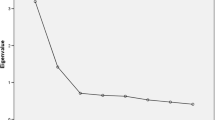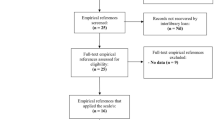Abstract
Purpose
Differential item functioning (DIF) is said to exist in an item if a subject’s response to the item is affected by other aspects than that which the test is intended to assess. DIF might affect the validity of a test. The aim of this study was thus to examine whether any of the items in the Epworth Sleepiness Scale (ESS) exhibits DIF regarding age or gender, and if so, to which degree.
Methods
Using previously collected cross-sectional ESS data from 1,168 subjects with different clinical characteristics (61% males, mean age 67.8 year (SD 12.2 year)), ordinal regression as well as Rasch-based DIF analyses were performed.
Results
Concerning age, both DIF analyses showed DIF for age in items 3 (inactive in a public place), 4 (passenger in a car), and 8 (in a car that has stopped in traffic). The Rasch model also showed DIF for gender in item 3. The DIF magnitudes as judged by McFadden pseudo-R 2 changes were, however, only minor.
Conclusions
ESS has small but reproducible DIF for age in items 3, 4, and 8. The detected DIF might be worth to consider in large-sample studies, although it probably has no effect on an individual basis.



Similar content being viewed by others
References
Johns MW (1991) A new method for measuring daytime sleepiness: the Epworth Sleepiness Scale. Sleep 14:540–545
Johns MW (1992) Reliability and factor analysis of the Epworth Sleepiness Scale. Sleep 15:376–381
Johns MW (2000) Sensitivity and specificity of the multiple sleep latency test (MSLT), the maintenance of wakefulness test and the Epworth sleepiness scale: failure of the MSLT as a gold standard. J Sleep Res 9:5–11
Chervin RD, Aldrich MS (1999) The Epworth Sleepiness Scale may not reflect objective measures of sleepiness or sleep apnea. Neurology 52:125–131
Violani C, Lucido F, Robusto E, Devoto A, Zucconi M, Ferini Strambi LF (2003) The assessment of daytime sleep propensity: a comparison between the Epworth Sleepiness Scale and a newly developed Resistance to Sleepiness Scale. Clin Neurophysiol 114:1027–1033
Hagell P, Broman J-E (2007) Measurement properties and hierarchical item structure of the Epworth Sleepiness Scale in Parkinson’s disease. J Sleep Res 16:102–109
Smith SS, Oei TPS, Douglas JA, Brown I, Jorgensen G, Andrews J (2008) Confirmatory factor analysis of the Epworth Sleepiness Scale (ESS) in patients with obstructive sleep apnea. Sleep Med 9:739–744
Hambleton RK, Swaminathan H, Rogers HJ (1991) Fundamentals of Item Response Theory. Sage, Newbury Park
Broström A, Arestedt KF, Nilsen P, Strömberg A, Ulander M, Svanborg E (2010) The side effects to CPAP treatment inventory: the development and initial validation of a new tool for the measurement of side-effects to CPAP treatment. J Sleep Res 19:603-611
Ståhlkrantz A, Sunnergren O, Ulander M, Albers J, Mårtensson J, Johansson P, Svanborg E, Broström A (2009): Difference in insomnia symptoms, daytime sleepiness, fatigue and global perceived health between hypertensive patients with or without risk of obstructive sleep apnea in a primary care setting. Eur J Cardiovasc Nursn 8S1, S24
Broström A, Strömberg A, Dahlström U, Fridlund B (2004) Sleep difficulties, daytime sleepiness, and health-related quality of life in patients with chronic heart failure. J Cardiovasc Nurs 19:234–242
Johansson P, Alehagen U, Svanborg E, Dahlström U, Broström A (2009) Sleep disordered breathing in an elderly community-living population: relationship to cardiac function, insomnia symptoms and daytime sleepiness. Sleep Med 10:1005–1011
Zumbo BD (1999) A Handbook on the Theory and Methods of Differential Item Functioning (DIF): Logistic Regression Modelling as a Unitary Framework for Binary and Likert-type (Ordinal) Item Scores. Ottawa, ON, Directorate of Human Resources Research and Evaluation. Department of National Defense
Hagquist C (2001) Evaluating composite health measures using Rasch modelling: an illustrative example. Soz Praventivmed 46:369–378
Teresi J (2006) Different approaches to differential item functioning in health applications: advantages, disadvantages and some neglected topics. Med Care 44:S152–S170
Nunnally JC, Bernstein IH (1999) Psychometric theory, 3rd edn. McGraw-Hill, New York
Jodoin MG, Gierl MJ (2001) Evaluating type I error and power using an effect size measure with the logistic regression procedure for DIF detection. Appl Meas Educ 14:329–349
Soldatos RS, Allaert FA, Ohta T, Dikeos DG (2005) How do individuals sleep around the world? Results from a single-day survey in ten countries. Sleep Med 6:5–13
SCB (Statistics Sweden): Labour Force Survey, August 2010; pp 1–270.
Hayes AL, Spilsbury JC, Patel SR (2009) The Epworth score in African American populations. J Clin Sleep Med 5:344–348
Sangal RB, Mitler MM, Sangal JM (1999) Subjective sleepiness ratings (Epworth sleepiness scale) do not reflect the same parameter of sleepiness as objective sleepiness (maintenance of wakefulness test) in patients with narcolepsy. Clin Neurophysiol 110:2131–2135
Olson L, Cole M, Ambrogetti A (1998) Correlations among Epworth Sleepiness Scale scores, multiple sleep latency tests and psychological symptoms. J Sleep Res 7:248–253
Derogatis LR, Rickels K, Rock AF (1976) The SCL-90 and the MMPI: a step in the validation of a new self-report scale. Br J Psychiatry 128:280–289
Rosales-Mayor E, Rey de Castro J, Huayanay L, Zagaceta K (2011) Validation and modification of the Epworth Sleepiness Scale in Peruvian population. Sleep Breath [Epub ahead of print] doi: 10.1007/s11325-011-0485-1
Chin K, Fukuhara S, Takahashi K, Sumi K, Nakamura T, Matsumoto H, Niimi A, Hattori N, Mishima M, Nakamura T (2004) Response shift in perception of sleepiness in obstructive sleep apnea–hypopnea syndrome before and after treatment with nasal CPAP. Sleep 27:490–493
Kaminska M, Jobin V, Mayer P, Amyot R, Perraton-Brillon M, Bellemare F (2010) The Epworth Sleepiness Scale: self-administration versus administration by the physician, and validation of a French version. Can Respir J 17:e27–34
Kumru H, Santamaria J, Belcher R (2004) Variability in the Epworth sleepiness scale score between the patient and the partner. Sleep Med 5:369–371
Miletin MS, Hanly PJ (2003) Measurement properties of the Epworth sleepiness scale. Sleep Med 4:195–199
Broström A, Strömberg A, Mårtensson J, Ulander M, Harder L, Svanborg E (2007) Association of Type D personality to perceived side effects and adherence in CPAP-treated patients with OSAS. J Sleep Res 16:439–447
Author information
Authors and Affiliations
Corresponding author
Rights and permissions
About this article
Cite this article
Ulander, M., Årestedt, K., Svanborg, E. et al. The fairness of the Epworth Sleepiness Scale: two approaches to differential item functioning. Sleep Breath 17, 157–165 (2013). https://doi.org/10.1007/s11325-012-0664-8
Received:
Revised:
Accepted:
Published:
Issue Date:
DOI: https://doi.org/10.1007/s11325-012-0664-8




